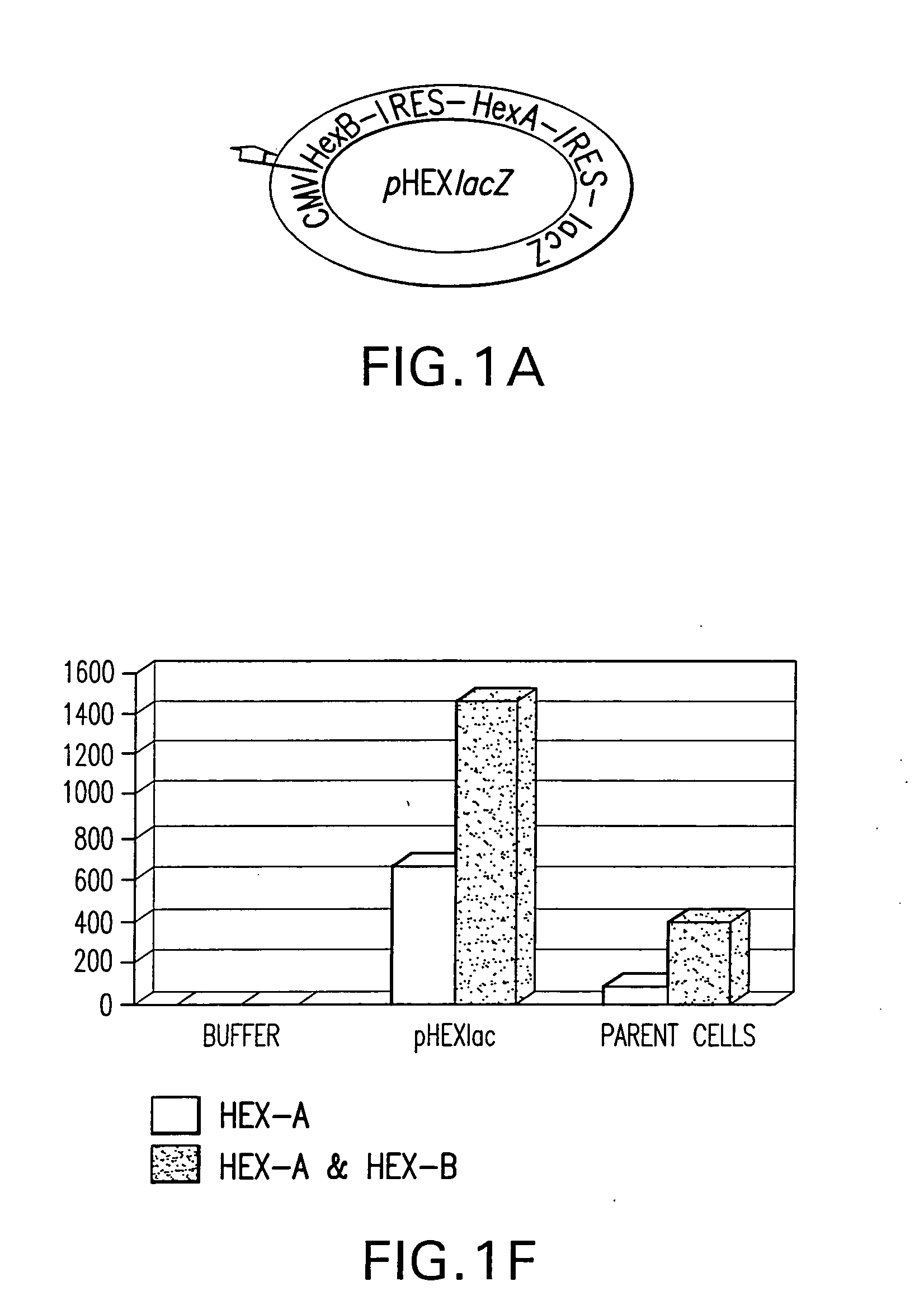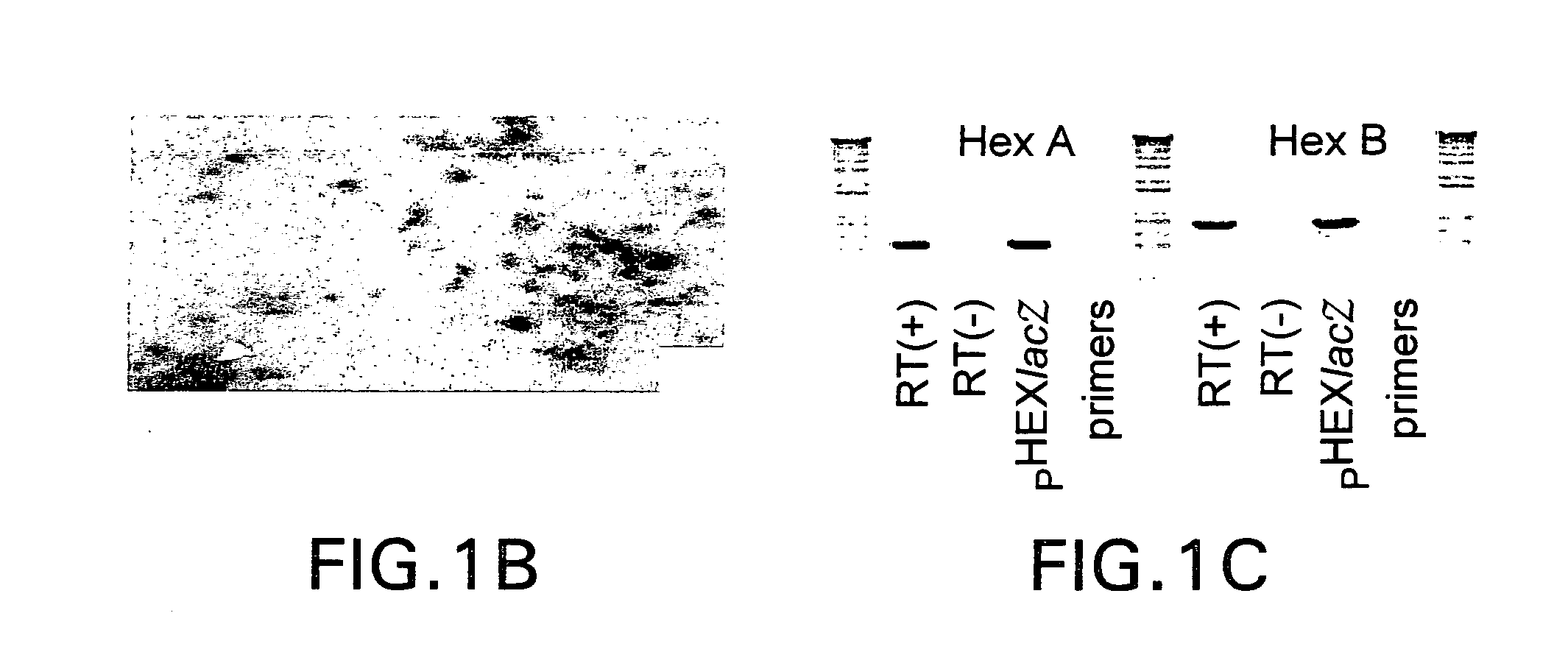Vectors having both isoforms of beta-hexosaminidase
a beta-hexosaminidase and isoform technology, applied in the field of lysosomal storage disorders, can solve the problems of severe cellular toxicity, decreased lysosomal activity, and accumulation of unwanted materials in the cell
- Summary
- Abstract
- Description
- Claims
- Application Information
AI Technical Summary
Problems solved by technology
Method used
Image
Examples
example 1
1. Example 1
Making β-Hex Constructs
a) Construction of Bicistronic β-Hex Construct
[0188] A bicistronic construct encoding for both isoforms of human β-hexosaminidase, hHexA and hHexB was made (FIG. 1). hHexB cDNA was isolated following Xho I digestion of pHexB43 (ATCC, Manassas Va.) and cloned into the Xho I site of pIRES (Clonetech Laboratories, Palo Alto Calif.) downstream of the vector's cytomegalovirus (CMV) promoter sequence. The HexA cDNA was isolated from pBHA-5 (ATCC, Manassas Va.) by Xho I digestion and was subsequently inserted into the Xba I site of pIRES(HexB) downstream of the vectors IRES cassette by blunt ligation. In this construct, the cytomegalovirus promoter (CMV) drives transgene expression, and the translation of the second open reading frame, HexB, is facilitated by an internal ribosomal entry sequence (IRES).
b) Results
[0189] The HEXlacZ encodes for both isoforms of human β-hexosaminidase, HexA & HexB. (FIG. 1) The vector pHEXlacZ is shown in FIG. 1(A). BHKH...
example 2
2. Example 2
Transfecting Constructs
a) Construction of the Tricistronic β-Hex Construct
[0191] A tricistronic construct encoding for both isoforms of human β-hexosaminidase, hHexA & hHexB, as well as the β-galactosidase reporter gene (lacZ) was also made. hHexB cDNA was isolated following Xho I digestion of pHexB43 (ATCC, Manassas Va.) and cloned into the Xho I site of pIRES (Clonetech Laboratories, Palo Alto Calif.) downstream of the vector's cytomegalovirus (CMV) promoter sequence. The HexA cDNA was isolated from pBHA-5 (ATCC, Manassas Va.) by Xho I digestion and was subsequently inserted into the Xba I site of pIRES(HexB) downstream of the vector's IRES cassette by blunt ligation. A IRES-lacZ cassette was obtained from Dr. Howard J. Federoff, University of Rochester School of Medicine and Dentistry, but can be produced using standard recombinant techniques with known reagents and was inserted downstream to HexA into the Sal I site of pHexB-IRES-HexA by blunt ligation. In this con...
example 4
3. Example 4
In Vivo Use of FIV HEX Vectors
[0195] FIV(Hex) was constructed by inserting the bicistronic gene HexB-IRES-HexA in the place of the reporter gene lacZ in the FIV backbone vector using standard mmolecular biology techniques. FIV(Hex) was prepared in vitro by transient co-transfection of the transfer vector along with the packaging and envelop plasmids into 293H cells. The virus-rich supernatant was centrifuged and the viral pellet was reconstituted in normal saline, and was then titered in CrfK cells by the X-Hex histochemical method (107-108 infectious particles / ml). The viral solution was injected intraperitoneally to 2 days old HexB− / − knockout mouse pups, which were allowed to reach the critical age of 16 weeks, when they displayed full signs of the lysosomal storage disease. For control, litermates were injected with the FIV(lacZ) virus, which is identical to FIV(Hex), but instead of carrying the HexB-IRES-HexA gene it carries the reporter gene lacZ. Locomotive perfo...
PUM
 Login to View More
Login to View More Abstract
Description
Claims
Application Information
 Login to View More
Login to View More - R&D
- Intellectual Property
- Life Sciences
- Materials
- Tech Scout
- Unparalleled Data Quality
- Higher Quality Content
- 60% Fewer Hallucinations
Browse by: Latest US Patents, China's latest patents, Technical Efficacy Thesaurus, Application Domain, Technology Topic, Popular Technical Reports.
© 2025 PatSnap. All rights reserved.Legal|Privacy policy|Modern Slavery Act Transparency Statement|Sitemap|About US| Contact US: help@patsnap.com



